 |
Home | Charity | Feedback |
India: Rajasthan:
Chittorgarh,
Devigarh,
Jaipur,
Jaisalmer,
Jodhpur,
Kumbhalgarh,
Ranakpur,
Ranthambore,
Ranthambore (Visit 2),
Udaipur
Ranthambore, Rajasthan, India: A roaring place by Prakash Bang, Editor in Chief 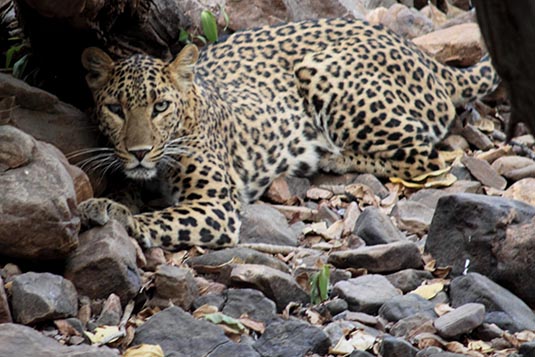 But not always. You have to be lucky to be able to sight tigers at the Ranthambore National Park – one of India’s fine reserves for tigers and other wild life. Not to forget hundreds of species of birds that the park attracts. The park covers an area of 370 square kilometers and is home to about 38 tigers. Well, the number is at the time of writing. Hopefully, the population would grow. India had over 40,000 tigers in the early fifties. Now, just about 1400 remain! I was guest of Sushil & Snehal Mantri, my cousins, who were celebrating their 25th wedding anniversary. We were hosted by the gracious couple at the Nahargarh Hotel which is just a few kms. away from the gates of the National Park. The property stands proudly in the middle of nowhere. Built in 2003 on the lines on Rajput architecture, the structure does remind the residents of the grandeur. The rooms have period furniture. However, the placement of airconditioners is not appropriate as the demands for cooling is much more. This wouldn’t have mattered much in more pleasant months but certainly not in midsummer. 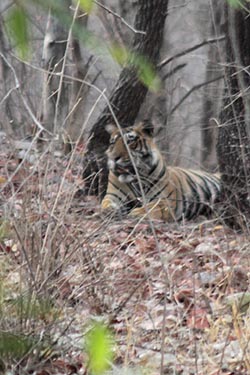 Talking of seasons, a good time to sight tigers would be May and November. The dry months deprive the park of vegetation thus increasing the chances of spotting tigers in a relatively open environment. Moreover, watering holes become that much more active. Temperatures in May will easily cross 45 degrees Celsius. November would be pleasantly cool. I was in Ranthambore in late April. Whilst the evenings were pleasant, daytime was hot as hell.
Talking of seasons, a good time to sight tigers would be May and November. The dry months deprive the park of vegetation thus increasing the chances of spotting tigers in a relatively open environment. Moreover, watering holes become that much more active. Temperatures in May will easily cross 45 degrees Celsius. November would be pleasantly cool. I was in Ranthambore in late April. Whilst the evenings were pleasant, daytime was hot as hell.
Ranthambore is about 180 kms from Jaipur which is the nearest airport. And the nearest railway station is Sawai Madhopur which is just about 10 kms. and is quite well connected with the rest of the country. Scores of hotels dot the neighbourhood and getting a room, across various budgets, should not be an issue. It’s a good idea though to have confirmed reservations especially whilst travelling in busy tourist months from October to January. We landed at Jaipur airport at 8 in the morning. A private cab got us to the hotel at around 1PM allowing a 30-minute break for breakfast in one of the road side joints in Tonk – a town about 90 kms from Jaipur and known for its beautiful structures from the era gone by. Visitors to the Ranthambore National Park need to follow fixed time schedules. The morning safari departs at 6 and the afternoon one at 3. Each safari lasts for about 3 hours. Any delays to get out of the park before the closing of the gates attract heavy penalties. Only authorized operators are allowed to run the safaris. Private vehicles are not allowed. There are two options. A 20-seater Canter or a 6-seater Gypsy. The cost is about Rs 250 per passenger. Still cameras can be taken in without cost. Video cameras and professional shooting attracts a fee. All hotels would be happy to book safari seats for you. During the rush season, it’s a good idea to book your safari in advance as the park has restrictions to the number of vehicles that can get in. There are 5 designated routes on which the vehicles ply. Once a route is decided, there’s no changing. Neither can the vehicles go from one route to another. Since tiger sighting is not guaranteed, tourists generally stay for a couple of days and opt for 2 or 3 safaris on different routes and times with the hope that luck would favour them. 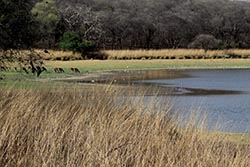 Post lunch we took a Canter. We would take route number 3. Whilst out on these open top tours don’t forget to carry your hat, camera, sunscreen and ample of drinking water. You will be riding for 3-hours and won’t be allowed to get down when in the park premises. Route number 3 has a big lake. Our guide (every vehicle has a driver and a guide) was hopeful that tiger would be around the waters. We were ready to roll – tense and excited.
Post lunch we took a Canter. We would take route number 3. Whilst out on these open top tours don’t forget to carry your hat, camera, sunscreen and ample of drinking water. You will be riding for 3-hours and won’t be allowed to get down when in the park premises. Route number 3 has a big lake. Our guide (every vehicle has a driver and a guide) was hopeful that tiger would be around the waters. We were ready to roll – tense and excited.
During the days of the raj, Ranthambore was the hunting grounds of Maharajas of Jaipur. Beautiful palaces were built for the comforts of the hunting troupes. Special canopies were built near the watering holes where the hunters would wait with loaded weapons waiting for the tigers and wild boars. It pains me to visualize a picture of a maharaja, safely located with a loaded gun, killing the helpless tiger from a distance. Cruel fun. I was told that at times killing of tigers became a necessity because of their growing population. Typically, a tiger needs 40 square kms of area for himself, a couple of tigresses and their cubs. Irrespective of the logic, I still don’t approve of the killings. Our first hour went on roaming about in search of the tiger. Enroute, we crossed the Jogi Mahal, a pink coloured summer palace on the banks of the Padam Lake and in the shades of India’s second largest Banyan tree. We also witnessed grazing deer, bathing boars, basking turtles, dancing peacocks, chirping birds, fishing storks, jumping monkeys… everything but roaring tigers. The driver and the guide did all their best to sight a tiger. One of their favourite tricks is to follow the calls of the monkeys, peacocks and the movements of the deer. On one occasion, we got quite close to a call, but there was no tiger in sight. The guide told us that a tiger is certainly out there, somewhere in the grass. Probably his judgment was right. But that was of no help to us. We had to return without any tiger sighting! That was indeed sad. But that didn’t stop us from dancing all night long, by the pool. It was a pre-eve party. The theme was retro. 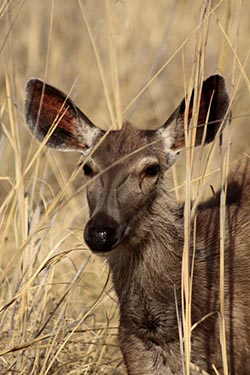 The next morning, 6 of us got together and hired a Gypsy. Thus began Operation Tiger II. Route chosen was number 1. This is the longest of all routes and takes you up and down the mountain and a valley. Deeper and deeper we went without any tiger sighting. We just saw a few deer and sambar grazing. After 90 minutes of driving around we finally came to a small water hole. And behold, sitting on the slopes above was a majestic tiger! It was a 2-year old male. The guide told us that this tiger has a twin sister and she should be around too. As per the guide’s judgment the tiger would eventually come down to the water for a drink. We waited. And waited.
The next morning, 6 of us got together and hired a Gypsy. Thus began Operation Tiger II. Route chosen was number 1. This is the longest of all routes and takes you up and down the mountain and a valley. Deeper and deeper we went without any tiger sighting. We just saw a few deer and sambar grazing. After 90 minutes of driving around we finally came to a small water hole. And behold, sitting on the slopes above was a majestic tiger! It was a 2-year old male. The guide told us that this tiger has a twin sister and she should be around too. As per the guide’s judgment the tiger would eventually come down to the water for a drink. We waited. And waited.
Looked like the tiger had no immediate plans to move. Thus, we decided to revisit the place after 30 minutes and take a chance to sight his sister elsewhere. While the sister was nowhere in sight, we had a bonus in the waiting. A leopard. She was sitting by a creek just about 20 feet away from us. We were there for about 10 minutes when she decided to walk back in the mountains above. As she started to move, monkeys in the distance began to call. Thrilled with our sighting, we came back to the water where the tiger was still in the same position. But the scene had changed. A pack of deer and sambars had arrived for a drink. Would I be able to click the tiger going for his kill? The chance was there. I was informed that tigers are not agile hunters. They hide themselves and attempt to attack only when the prey is within easy reach. The deer were a bit tense as they must have smelt the lurking danger. But the sambar (tiger’s favourite meal) that have a poor eyesight was not really bothered. And then there was a distress call from another sambar that was quite at a distance but had sensed the presence of the tiger. The sambar who was near was actually confused. He heard the call but failed to take notice. Anyway, after moving around for a while, he must have spotted the looming danger. Off he bolted. In minutes, the coast was clear. There was no sign of any deer or sambars. 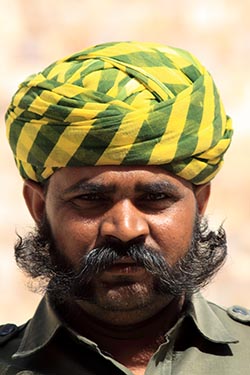 This was not new. The tiger is successful in only one out of ten hunting attempts. Today was not his day. But our day was made. We were hanging out there for the tiger to come to the waters. After some time, the tiger walked towards us but then turned to his right, sought a shade and preferred to rest. Our time was up. We had to leave. Here are some tiger facts: Tiger lives and hunts alone; average lifespan is about 17 years; average weight is about 250 kgs; can eat up to 20 kgs of meat at one go; the stripes are unique to every tiger.
This was not new. The tiger is successful in only one out of ten hunting attempts. Today was not his day. But our day was made. We were hanging out there for the tiger to come to the waters. After some time, the tiger walked towards us but then turned to his right, sought a shade and preferred to rest. Our time was up. We had to leave. Here are some tiger facts: Tiger lives and hunts alone; average lifespan is about 17 years; average weight is about 250 kgs; can eat up to 20 kgs of meat at one go; the stripes are unique to every tiger.
While in Ranthambore, I would recommend a visit to the majestic Ranthambore Fort too. After a sumptuous lunch and afternoon siesta I began my climb to this fort that stands up 700 feet. There’s no entry fee to visit the fort. From the parking lot, a series of comfortable steps takes you up the fort. Built in the year 944 the fort has a bloody history. The rule changed hands from the Meenas to Rajputs to Sutans to Mugals. To cut the long story short, the fort finally passed on to the Maharaja of Jaipur in the 17th century. Strategically located, the fort offers excellent view of the Ranthambore National Park and is home to the famous Ganesh temple as also the temples of Lord Shiva and Ramlala. There’s also a Jain temple of Lord Sumatinath and Lord Sambhavanath. That evening was a gala dinner. The setting was a true darbar – befitting a Maharaja, his Maharani and the royal guests. After wishing the couple well, we rested for the night. The next day we would began our adventure in the royal land of Jaipur. Ranthambore Image Gallery  Photo viewer Photo viewer
|
|
|
Home |
Charity |
Feedback
Privacy Policy | Terms of Usage © YoGoYo.com. All rights reserved. |









































